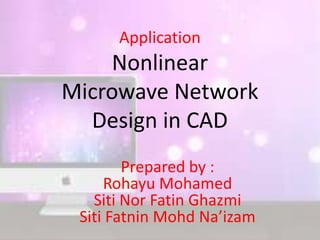
Application of Parallel Processing
- 1. Application Nonlinear Microwave Network Design in CAD Prepared by : Rohayu Mohamed Siti Nor Fatin Ghazmi Siti Fatnin Mohd Na’izam
- 2. INTRODUCTION • Microwave network designers is important to new development in computer-aided design techniques. • Parallel processing is applied to the CAD of nonlinear microwave circuits. • The process does not require iteration when solving the nonlinear network. • Each circuit element has an identifiable process and all the processes work in parallel. • These properties result in a very efficient algorithm that can be installed on a desktop computer with a Transputer board.
- 3. PARALLEL ARCHITECTURE USED • Nonlinear microwave network contains the linear resistors, voltage- and current controlled nonlinear resistors, and parametric resistors. • Linear and nonlinear inductors and capacitors • Linear and nonlinear controlled sources • Independent sources • Distributed delay elements (transmission lines, micro strips, etc.).
- 4. • Any CAD procedure has to satisfy both Kirchhoff‘s laws and the Z-V relations of the elements (linear, nonlinear, integral, differential, delay, etc.). • OCCAM as the programming language parallel processes communicate by synchronized unbuffered messages along dedicated “ point-to point” channels. • Each process inputs in parallel from all its input channels, performs some action (activity) inside the process, and outputs in parallel to all its output channels.
- 5. • Each Transputer has four hardware links, each of which can be mapped into a bidirectional pair of OCCAM channels. • One of the five Transputers was used as a “host” to act as an interface between the user and the remaining four-Transputer network, which carries out the implementation of the algorithm. • The efficiency of configuring the network and the finite communication time between Transputers will affect the reduction in time.
- 6. P1 is the Maestro process and the input/output procedures. P2 includes all the TREE processes. P3 includes all the COTREE processes. P4 includes all the signal manipulation processes of the KVL side (Fig. 1). P5 includes all the signal manipulation processes of the KCL side (Fig. 1).
- 8. ADVANTAGES • Significant reduction in computational time • Optimization becomes feasible even on a desktop computer. • The developed programs run on an AT desktop with one Transputer board capable of concurrent processing speeds of over 80 MIPS at a processor speed of 20 MHz. • A new representation of microwave and nonlinear circuits has been developed to suit the required parallelism. • Applications to the analysis of nonlinear amplifiers and frequency multipliers are described. • The algorithm also offers the possibility of optimization due to the improvement in computational speed and the fact that each element is assigned an identifiable process. • Parallelism can be featured independently in the mathematical algorithm, the programming language, and the hardware.
- 9. CONCLUSION • A powerful new algorithm has been developed for analysing nonlinear microwave networks using parallel processors. • The system offers the possibility of analysing and optimizing these circuits using low-cost desktop computers and eliminates the need for workstations or mainframes. • By identifying every circuit element with a process, efficient optimization is feasible. • A further increase in speed is possible by the simple addition of more Transputers
- 10. • There are a number of available computer programs for analysing linear and nonlinear microwave networks. Both time-domain and harmonic balance methods are based on serial processing. They both require powerful computers, and no optimization is offered due to the inordinate time required. In order to reduce the computational time and hardware requirements, a new approach to the circuit simulation is required. • Any number of Transputers can be used. However, the system of five Transputers was found adequate for good programming efficiency. • Transputer is a processor which implements the process model of communication embodied in its native parallel programming language, OCCAM. • The serial communication links are used to connect several transputers in a network (as shown in the figure). The result is a MIMD-parallel (Multiple- Instruction, Multiple-Data) system. Since the system has distributed memory, transputers use a message-passing protocol to exchange data. • The host Transputer has 2 Mbytes of dedicated DRAM and each of the other four Transputers has 256 kbytes of dedicated DRAM. Theoretically, the computation time is inversely proportional to the number of Transputers used. • Because of the parallel design of the simulation there is great flexibility as to how this can be done. Almost any partition from all the processes on one Transputer down to one process per Transputer is possible (although perhaps not sensible).
